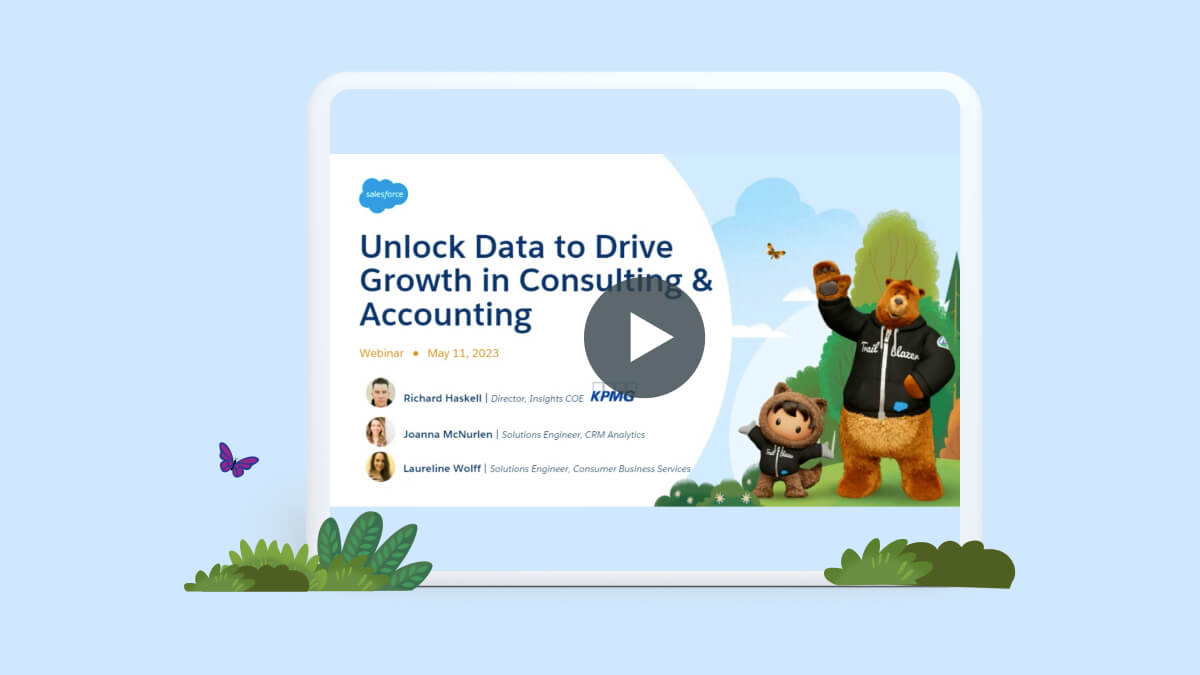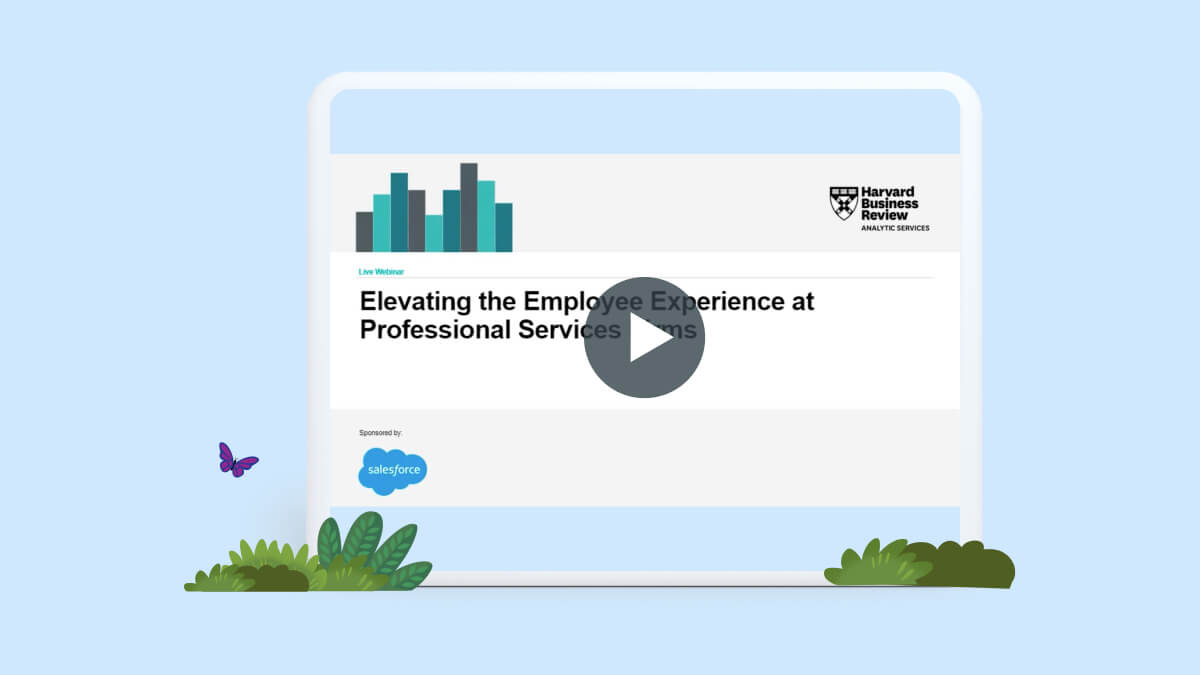How Consulting & Accounting Firms Can Harness Data to Unlock Opportunity and Drive Growth
Discover how leveraging data and AI can help you stay ahead of the competition
Lead Solution Engineer at Salesforce
Lead Solution Engineer at Salesforce
Consulting and accounting firms are in the unique position of having to cope with current market challenges while also taking on a leadership role. Clients expect them to be ahead of the game. They look to them for help navigating economic difficulties, digital transformation and an increasingly precarious market. In order to deliver, firms need to find a competitive edge that differentiates them from the competition. They need the ability to identify high potential opportunities that will meaningfully transform their business, help uncover new revenue streams, and ultimately drive growth.
Data is the key to growth
Firms guide clients through meaningful change, helping them with everything from disruption to optimization. The firms that do it best are those who are able to take an all encompassing, multifaceted approach that's both efficient and holistic.
Effectively helping clients is not about offering up a shiny new solution for every new problem, but rather taking an approach grounded in data. A data-driven approach enables a consulting and accounting firm to do things like understand the serviceable market, identify any unmet client needs, and assure them they have a right to win. It also gives them the ability to understand what types of solutions, products or playbooks are appropriate for a set of clients in a given industry or circumstance. However, firms can only take this type of approach if they themselves have a data practice in place.
Consulting and accounting firms need the ability to eliminate data silos, connect data across their organization, and ensure that everything they know about each client, service and offering is in one central location. This type of integration enables every member of the team to access, utilize, and optimize the data at their disposal in order to drive growth for the firm.
Data + AI + CRM
How does this work?
Integrating data, AI, and CRM is simple, but not necessarily easy. Doing it properly often requires a technology partner with the experience and knowledge to “get it right.” That partner can help you connect all relevant data sources, ingest and harmonize the data, and then ultimately unify it so that you can bring identities together and create a 360-degree view of each client.
Once these steps have been taken, your firm’s data will be organized, optimized and actionable. You can now put your clients at the center of everything you do. 360-degree complete client profiles will enable your teams to deliver real-time client engagement and insights. And, because all the information lives on a single, centralized platform, each and every team working with that client (whether that be marketing, service, sales or something else) can now take direct action in context of the client profile.
This ability to organize data collectively enables you to not only gain a deeper understanding of your clients and overall business operation, but to actually take action. It moves your data from simple information to a powerful tool that can be used to drive business forward. What’s more, integrating data, AI, and CRM not only houses and stores your data, but also makes it possible to analyze it, extract insights, and provide predictive ‘next best actions.’ Teams can identify growth opportunities, use automated processes and AI to assure that each and every one of those opportunities are properly captured, and tailor marketing and sales materials to each and every client, at scale. For example, the platform might alert a partner that a current client could benefit from an additional product or service. It could then use generative AI to help create prompts or a sales script that the employee could use throughout the sales and negotiation process. Once the sale has been made, the sales team could then pass all relevant information and history off to the marketing team, enabling them to add that client to a curated journey that's more likely to resonate.
Driving growth through streamlined operations, automation, and AI
Helping individual employees meet goals and achieve business success
Most partners know their business incredibly well, but this doesn’t necessarily mean they are managing that business optimally. Many are still using spreadsheets or notepads to outline each deal and keep track of all the information they need. The problem with this is twofold. First, storing important data on an individual partner’s notepad or spreadsheet precludes anyone else from benefiting from that information. And second, when data is stuck on a notepad, you can’t report on that data or use it to drive further success.
Moving to a robust digital platform is a gamechanger. An integrated platform centralizes data, allowing partners to track, edit, and take action on all deals from a single screen. This not only provides a unified view (negating the need to flip between screens, dashboards, or applications) it also brings in other relevant information that sales teams may not have previously had access to. This means partners have the data they need to close current deals, identify new ones, and forecast into the future. They can manipulate their view, isolate the information they care about, and then get insight into that information (for example opportunity scores, likelihood of closing, etc) at the simple click of a button. The system also helps with prioritization, using insights and AI to highlight the strongest leads, flag deals in jeopardy, and provide guidance in order to create scenarios with the highest likelihood of success.
What does this look like in action?
From the moment a seller logs on, they see a single dashboard from which they can easily get a good sense of where their business stands. This high level overview allows them to track goals and actions to gain a clear understanding of things like deals in progress, productivity, and whether they’re coming in on, above, or under target.
They can then drill into these things for a more detailed picture of specific goals, actions, and behaviors. For example, if a seller is nearing the end of a quarter and wants to drill down into the business they have committed, they can click into that specific section on the dashboard, and automatically reveal their committed sales. They can see all the opportunities that have closed, as well as all the current opportunities in the pipeline, including deals that have been committed but not yet closed. They can also go one step further and identify which, if any, are in jeopardy of not closing.
If the partner is alerted to a deal in danger of not closing, they can click into the specific commitment to see why the system has flagged it as an issue. Then, rather than having to toggle to another system to do something about the “flagged opportunity,” the seller can open a record, make a task, create an event, or email somebody directly from the dashboard, saving valuable time.
In this case, the seller might open a record. Upon doing this, they would immediately be able to see a top level overview of everything they need to know. This includes things like revenue over time, support cases, commitments in the pipeline, and other data all pulled from systems across the organization. This kind of holistic view makes everything instantly and easily accessible, enabling a seller to more effectively manage their business. Sellers can click into this top level overview to get AI driven insights into metrics like predicted win, probability, or estimated days to close. These AI insights help Salesforce users forgo “gut feeling” for data-driven decisions. It also enables them to see the “why" behind the analysis, allowing the seller to understand exactly what is influencing the score.
In this case, the AI model might reveal that a competitor or an expired quote status are contributing to a deal’s low likelihood to close. The model can then provide recommendations as to how this score might be improved, allowing the seller to take action directly from the platform. The seller might set up a meeting and/or get the deal compete team involved to try and save the business. Once this action has been taken, the model will reanalyze the available information and generate a new prediction. This allows the seller to see the effects of the action taken, as well as reprioritize the opportunity based on the new predicted likelihood of closing.
Giving managers the tools they need to help teams increase productivity and drive growth
Managers' success is highly dependent on the success of the people they lead. They need a way to quickly ascertain how their teams are doing across a variety of metrics, benchmarks, and goals. In the past this would have required either a lot of manual work on the part of the manager, or a host of custom built tools and applications that could track different things across a bunch of disconnected windows and systems. An integrated platform negates the need to do either.
The ability to do everything from a centralized platform not only increases efficiency, it creates a more holistic picture, enabling managers to get a complete view in one central location. Managers can use different dedicated dashboards to see things like team performance, whether quotas are being hit, and who is focusing on what. They can slice and dice by a bunch of different metrics to get a good pulse on exactly how the team is doing in this moment, or take a more high-level view to see the team’s performance across a variety of metrics over time.
Account management
Overseeing remote teams in disparate locations
Building a foundation today, to achieve success tomorrow
Related Content

Webinar
Unlock Your Data to Drive Growth in Consulting & Accounting

Article
Three Steps to Drive Efficient Growth for Consulting & Accounting

Webinar
Elevating the Employee Experience at Professional Services Firms Webinar
About the Author
Laureline Wolff is a Lead Solution Engineer at Salesforce
Johanna McNurlen is a Lead Solution Engineer at Salesforce
More Resources

Video
Harness Data to Deliver Smarter Accounting and Consulting

Report
Rise of RevOps for Professional Services from Forrester Consulting

Report
State of Sales Report


